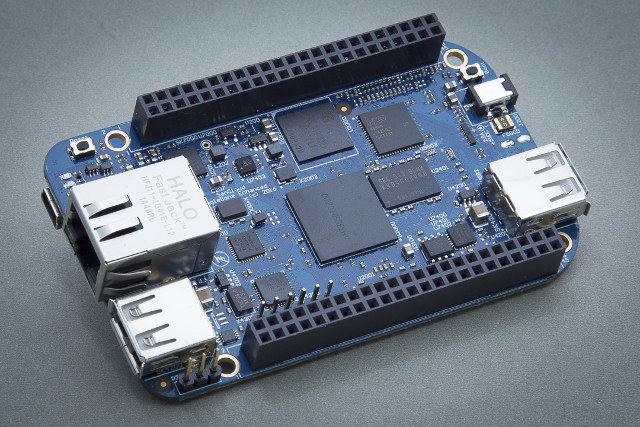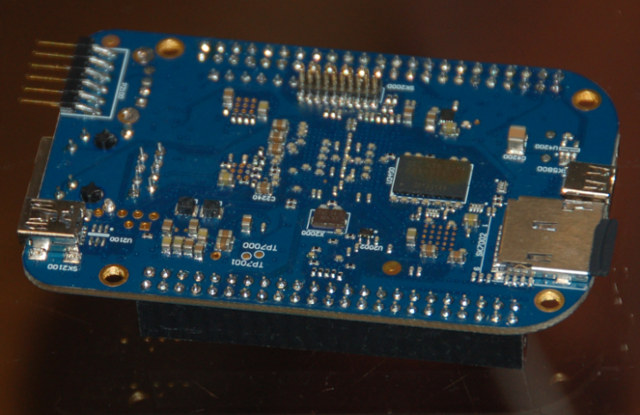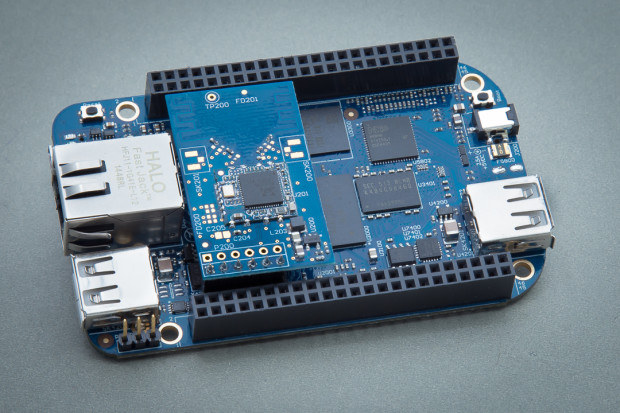It’s nice to see BeagleBone Black‘s open source hardware being leveraged by third parties, as we’ve already seen designs such as BeagleBone Green and BeagleBone Black Industrial 4G in the past, and now UK based SanCloud has decided to launch BeagleBone Enhanced on Indiegogo (flexible funding).

BeagleBone Enhanced board specifications with bold highlights showing improvements over the BeagleBone Black Rev. C:
- SoC – Texas Instruments Sitara AM3358 Cortex A8 @ 1 GHz + PowerVR SGX530 GPU
- System Memory – 1GB DDR3 RAM @ 800 MHz
- Storage – 4GB eMMC flash + micro SD slot, optional 1MB SPI NOR flash
- USB – 2x USB 2.0 host port (A type), mini USB OTG port, 2x USB interfaces via expansion header
- Serial Port – UART0 via 3.3V TTL header
- Ethernet – Gigabit Ethernet
- Video Output – micro HDMI with EDID support, up to 1280×1024 resolution.
- Audio Output – Via HDMI
- Sensors
- Optional 6 axis gyro + accelerometer (9-axis adding compass will be used instead if funding target is reached) – InvenSense MPU-6050 or MPU-9250
- Optional barometer, pressure, and temperature sensor (ST Micro LP331)
- Optional 6 axis gyro + accelerometer (9-axis adding compass will be used instead if funding target is reached) – InvenSense MPU-6050 or MPU-9250
- Expansion Connectors – 2x 46-pin headers
- Debug Ports – Optional onboard 20-pin CTI JTAG + Serial Header
- Indicators – 1 for Power, 2 for Ethernet, and 4 user’s LEDs
- Input – Reset, boot, and power buttons
- PMIC – TPS65217C PMIC regulator and one additional LDO
- Power – mini USB, DC Jack, or 5VDC via expansion header
- Dimensions: 86.4 x 53.4 mm
 There are optional items because two versions of the board will be manufactured: BeagleBoard Enhanced Light, and BeagleBoard Enhanced, with the latter including all optional items. Both boards are fully supported and licensed by beagleboard.org, and are software compatible with BeagleBone Black, so you can run Debian, Android, Ubuntu, Cloud9 IDE, etc… on the board . A separate module with RealTek RTL8723 for 802.11 b/g/n WiFi and Bluetooth 2.1/4.0 LE can also be added to the board.
There are optional items because two versions of the board will be manufactured: BeagleBoard Enhanced Light, and BeagleBoard Enhanced, with the latter including all optional items. Both boards are fully supported and licensed by beagleboard.org, and are software compatible with BeagleBone Black, so you can run Debian, Android, Ubuntu, Cloud9 IDE, etc… on the board . A separate module with RealTek RTL8723 for 802.11 b/g/n WiFi and Bluetooth 2.1/4.0 LE can also be added to the board.

The company aims to raise $32,500 to go ahead with manufacturing. A $52 early bird pledge should get you a BB Enhanced Light and $57 a BB Enhanced, and $65 BBE with WiFi and Bluetooth, once all early bird rewards are gone, pricing ranges between $63 and $77. Shipping is not included, but only adds $7 to the total. Delivery is scheduled for September 2016.

Jean-Luc started CNX Software in 2010 as a part-time endeavor, before quitting his job as a software engineering manager, and starting to write daily news, and reviews full time later in 2011.
Support CNX Software! Donate via cryptocurrencies, become a Patron on Patreon, or purchase goods on Amazon or Aliexpress




